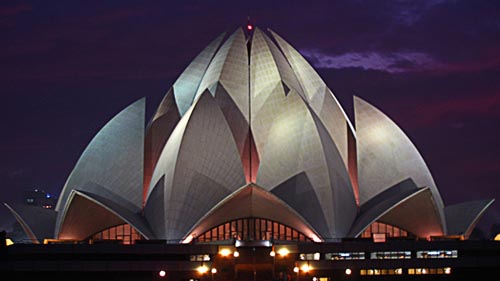Lotus Temple Delhi

Information on Lotus Temple (New Delhi) - History & Architecture
The Lotus Temple is situated in the capital city New Delhi, India. It is also referred as the Bahai House of Worship or the Bahai Temple. The Lotus Temple is considered to be quite an imperative landmark in New Delhi. The unique characteristics of the temple make it one of the most highly visited edifices nationally as well as globally. The construction of the Bahai Temple was completed in the year 1986. The temple is precisely positioned in Kalkaji, New Delhi. The Bahai House of Worship in the Indian subcontinent connects other six Bahai Houses of Worship across the globe and is known to share few ideas in relation to the basic form of design. However, inspite of sharing few of the fundamental design concepts as per the Bahai scripts, the Lotus Temple is popular for its individual discrete cultural individuality exemplifying the belief of harmony in diversity. The Lotus Temple follows the principles mentioned in the Bahai texts and thus, welcomes people from all walks of life irrespective of their caste, religion or other sorts of dissimilarity.
Lotus Temple Delhi Architecture
The son of the initiator of the Bahai religion, Abdul-Baha specified a circular shape with nine sides to be an indispensable attribute with regard to a House of Worship. It has been also learnt that the Bahai texts forbid the demonstration of any form of statues, images or pictures inside the House of Worship. The texts also prohibit the inclusion of altars or podiums in its architectural pattern. The Lotus Temple enjoys worldwide popularity owing to its unique design and pattern of architecture. Lotus is considered to be a sign of purity as well as love.
The Lotus temple, true to its name, appears like a lotus and sends across a message that defines immortality. This outstanding edifice was constructed by a Persian architect Fariborz Sahba who was from Canada. The construction of the temple involved raw materials such as cement, sand, dolomite and marble. The temple appears like a lotus which is half opened from top. It took 10 years to complete the construction of the structure and engaged around 800 workers. The team consisted of technicians, workers and even engineers. The temple has nine doors as well as reflecting pools. The Lotus Temple stands tall at a height of 40 metres. The use of white marble is believed to have further enhanced the attractiveness of the temple.
Lotus Temple Delhi History
The half opened lotus flower of the temple comprises 27 marble made self-supporting and separate petals. The complete team engaged behind the construction of the temple worked meticulously in order to offer shape to such a complex structure. The temple has double surfaces that are curved in shape. The temple is believed to possess the ability of accommodating around 2,500 people. The exterior of the Lotus Temple has been made from white marble sourced from the Pentil Mountain which is situated in Greece. This is believed to be the same mountain from where marbles were used for constructing numerous other Bahai Houses of Worship as well as ancient monuments. The property of the Lotus Temple spreads around 26 acres.
Lotus Temple Delhi Tourism Significance
The Lotus Temple is believed to attract a crowd of over 50 million people hence, placing it amongst the most highly visited structures across the world. The number of people visiting the Lotus Temple from the year 1986 to 2002 exceeded the amount of people visiting the Taj Mahal and the Eiffel Tower. More of all, it is also one of the important tourist attractions of Delhi, which is also the part of attraction of Delhi Darshan.
- Andaman Nicobar Monuments
- Andhra Pradesh Monuments
- Assam Monuments
- Bihar Monuments
- Chhattisgarh Monuments
- New Delhi Monuments
- Goa Monuments
- Gujarat Monuments
- Haryana Monuments
- Himachal Pradesh Monuments
- Jammu and Kashmir Monuments
- Karnataka Monuments
- Kerala Monuments
- Madhya Pradesh Monuments
- Maharashtra Monuments
- Odisha Monuments
- Punjab Monuments
- Rajasthan Monuments
- Tamil Nadu Monuments
- Telangana Monuments
- Uttar Pradesh Monuments
- West Bengal Monuments